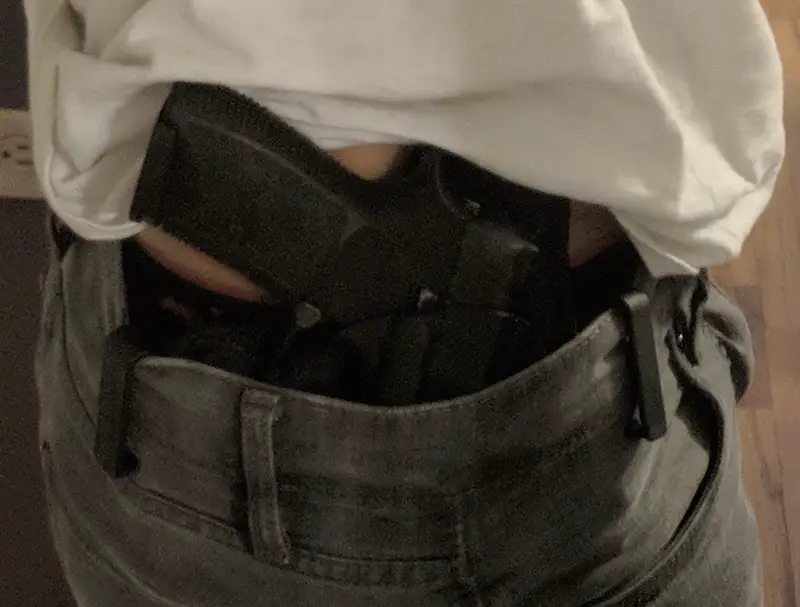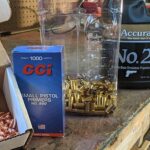Alright, so you’re picking up a new gun from your local FFL dealer. But, aren’t there some things you should be inspecting on a new gun before buying? The short answer is yes. You should inspect several things before buying a new gun, and throughout the process. Here’s a list of what to look for:
- Check all basic functions
- Visual wear on moving and stationary parts
- Rattling or loose gun parts
- Inspect the sights
- Check the serial number
Table of Contents
Etiquette for Inspecting A New Gun
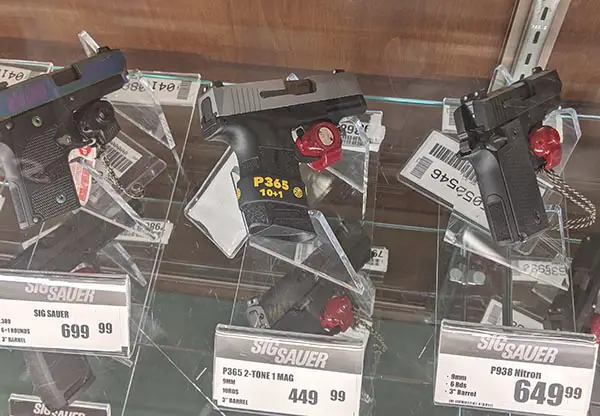
Before we get into exactly what (and how) to inspect a new gun, let’s talk about protocol. While there are certain visual inspections you can make, some actions are frowned upon without the store owners permission.
However, this shouldn’t deter you from performing these actions in whole or in part. But, there is a certain etiquette you should follow.
Practice Basic Firearm Safety
It should go without saying, that you should follow the rules for the safe handling of firearms. Therefore, don’t go waving or pointing the gun at the FFL dealer or any other patrons.
Ideally, you’ll know the basics about the firearm you’re looking to purchase. However, that isn’t necessary as many patrons are first time buyers. But, if you act in accordance with the basic safety rules your time will be much more pleasant.
Ask Owner Permission or Assistance
Additionally, many items on the checklist require more than a cursory glance of basic handling of the firearm. Therefore, you’ll want to get the owner permission before proceeding with certain parts of your inspection. I’ve noted which items are likely to require permission.
1. Check Basic Firearm Function
This seems fairly evident, right? Well, before skipping this section take a glance and make sure you’re thinking of everything.
Dry Fire
Before you go ahead and cycle the handgun and squeeze the trigger, it’s best to get owner permission to dry fire. Explain that you are just inspecting the action of the firearm and you’ll practice safe firearm handling throughout.
When you are inspecting the gun, make sure the trigger is smooth and there are no hang ups. Additionally, check the trigger reset by slowly letting the trigger out after you dry fire.
Inspecting The Action
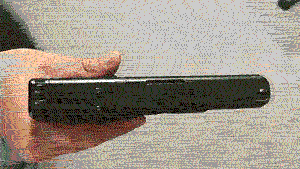
Inspecting the Action On An Automatic
Next, inspect the action of the firearm by making sure all parts move freely. For an automatic, this means making sure the slide moves completely back and goes into battery when the slide is released. I recommend rigorously cycling an automatic to ensure it goes into battery every time.
Afterwards, ensure that you can lock the slide back without issue. Additionally, you should work the slide stop and ensure that it returns to battery. Above is a quick animation of locking the slide back and manually cycling a handgun.
Inspecting the Action On A Revolver
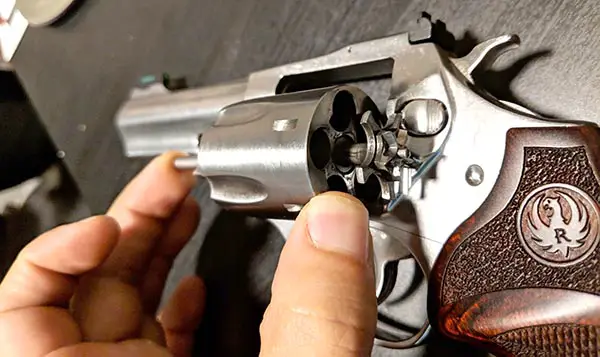
However, the action on a revolver is a bit different, so you’ll want to look at a few different parts of the handgun. First, make sure you can eject the wheel by testing the cylinder latch. Additionally, make sure that latch works to keep the cylinder in battery.
Also check that the ejector rod operates correctly, above is an image of how the ejector rod should operate.
Next, make sure to inspect that the cylinder rotates freely when ejected. Afterwards, put the revolver back into battery. First, manually cock the hammer to ensure the wheel rotates in single action. Second, squeeze the trigger and make sure the cylinder rotates in double-action.
Rifles and Shotguns
The process for inspecting a rifle is similar to that of an automatic handgun. Except in lieu of a slide, rifles have a bolt/bolt carrier that move. For bolt action rifles, you’ll need to manually manipulate the bolt. Semi-automatic rifles will usually have a charging handle that you can use to cycle the firearm.
Shotguns with a charging handle can be inspected similar to a rifle. However, pump shotguns will need to be manually cycled similar to a bolt action rifle. Additionally, there are also over-under and single barrel shotguns. Opening the action on these usually involves tilting the barrel to open the action.
Using Dummy Rounds
Dummy rounds are a great tool to ensure that the extractor isn’t damaged. However, make sure you have owner permission before you go sticking dummies in their firearm. Place the fake round in the chamber of an automatic and cycle the handgun. For revolvers, you can use the dummy rounds to test the ejector rod.
Decocker & Magazine Release
Some handguns have a decocker. You can inspect whether the decocking lever lowers the hammer on the handgun. Unfortunately, checking whether the decocker works safely should be done on the range.
Another quick inspection you can perform is on the magazine release button. First, insert an empty magazine into the mag well. Next, ensure that the magazine is seated firmly and doesn’t fall out on its own. Finally, press the magazine release button and inspect whether it drops unimpeded.
Every handgun is different, and the force of the magazine being ejected will differ. You’re really just checking to make sure that the magazine doesn’t snag or get stuck/wedged in the magazine well.
2. Inspect The Gun For Wear & Imperfections
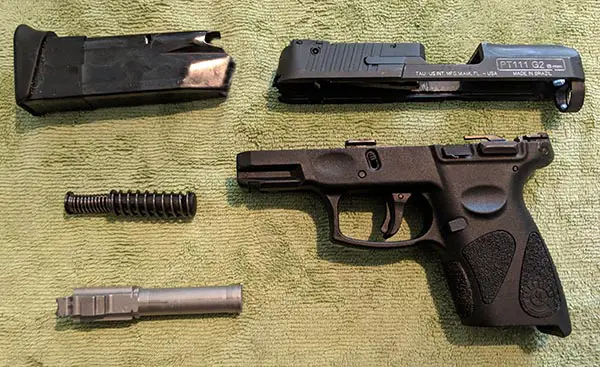
Part of owning a firearm is being able to clean and maintain it. Regardless of whether it’s a pistol, shotgun, or rifle each gun has a process for breaking the firearm down for cleaning.
Before you attempt to field strip a gun inside a shop you should ask permission! You should be allowed to perform this for the purposes of inspecting the gun. However, some sellers are finicky, and may prefer to perform the field strip themselves.
Usually, this type of inspection is most beneficial when buying a used gun. However, its also good for familiarizing yourself with the process of field stripping.
Inspecting The Barrel
You should inspect the barrel carefully, especially if the firearm is used. Look at the rifling and overall condition of the barrel. If there are scratches on the barrel interior, or an excessive amount of buildup you should be concerned. Generally, this means the firearm was not maintained properly and you may be in for problems in the future.
Another area that should be checked is the feed ramp, which is usually the area opposite the muzzle. Inspect the feed ramp to ensure it is smooth and doesn’t have deep gouges or dings. Usually, a marred feed ramp will lead to failure to feed.
Checking The Slide & Frame
While the handgun is in pieces, it’s a good time to do a closer visual inspection. You shouldn’t see any burrs or metal shavings where the slide contacts the frame. Additionally, look for any deep gouges or imperfections that can be covered up with grease that is usually caked on by the manufacturer.
3. Check For Rattling & Loose Parts
Now that you’ve stripped the handgun down and you’re finished inspecting the gun in pieces it’s time to put it back together. Presumably some of that gun grease has rubbed off. Visually inspect the gun and make sure all parts fit together snugly.
First, make sure that slide matches up with the frame without any lateral wiggle. Check all moving parts to ensure they only move in the intended direction. Give the handgun a good shake and see if you feel parts shifting or you hear pieces rattling.
4. Checking The Sights
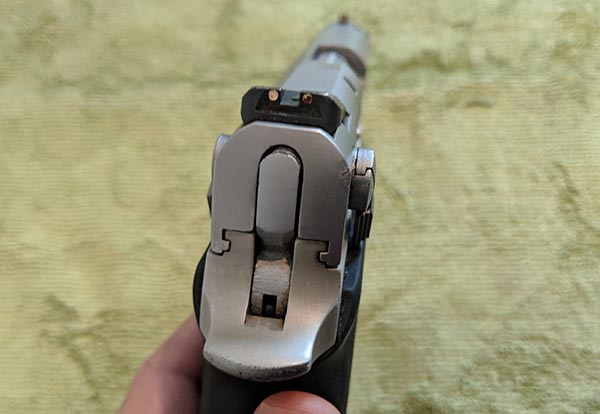
Alright, you’ve done your tests. After ripping things apart and inspecting the gun you put it back together and things fit tight. However, there’s one more thing you need to check on the gun. Ensure that the sights are in good working order and check the alignment.
When I talk about good working order, I’m really talking about sights with special functions. For instance, are you getting a gun with tritium sights? Have you checked that they still glow?
Also, you should ensure that the sights are aligned and that they didn’t drift. Sometimes a sight will drift in transit. If buying a used gun, the sights may have drifted over time simply from being shot. While not a huge deal, you don’t want to have to pick up a sight pusher to fix the issue yourself.
5. Check Your Serial Number

This is less of an inspection of the actual firearm, and more a double-check during the buying process. However, you’ll need the serial number on the gun in order to run any kind of background investigation of your own.
This is less of an issue for new guns, but if you’re buying a used gun you’ll want to know about the guns history. For instance, has the gun been reported stolen? You don’t want to end up using your gun for self defense only to be escorted to the police station in a set of handcuffs because you bought a stolen firearm.
Additionally, any gun with a defaced or unreadable serial number is suspect. It is illegal to remove the serial number from a gun. Therefore, if you are unable to inspect and confirm the serial number, walk away from the sale.
Where To Find The Serial Number
Since the Gun Control Act of 1968, manufacturers must include a serial number on each gun they produce. Usually, this information can be found on the frame of the gun. However, if you’re unable to locate the gun serial number you can check a few different places.
- Frame of the gun
- Slide on a handgun
- Top of the barrel, usually visible at the ejection port
- For rifles, you can inspect the receiver or bolt
Parting Shots
Hopefully you’ve found some useful information in this article. If you’re a first-time gun buyer, you should also check out the article I wrote just for you. Want to add something to this checklist for inspecting a new gun before buying? Leave a comment below and share your thoughts with our other visitors. Be sure to follow on Facebook.

